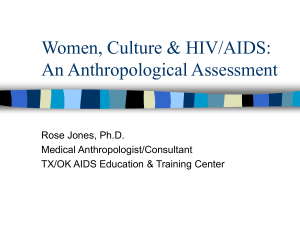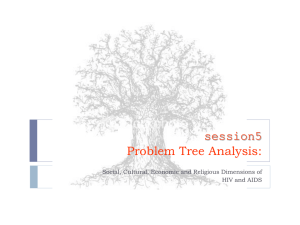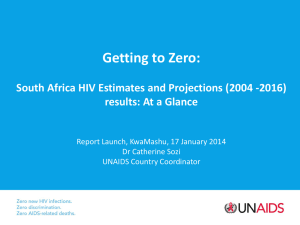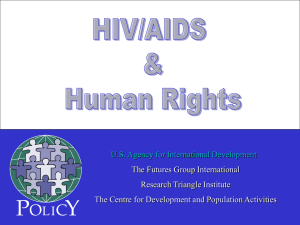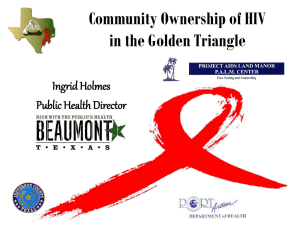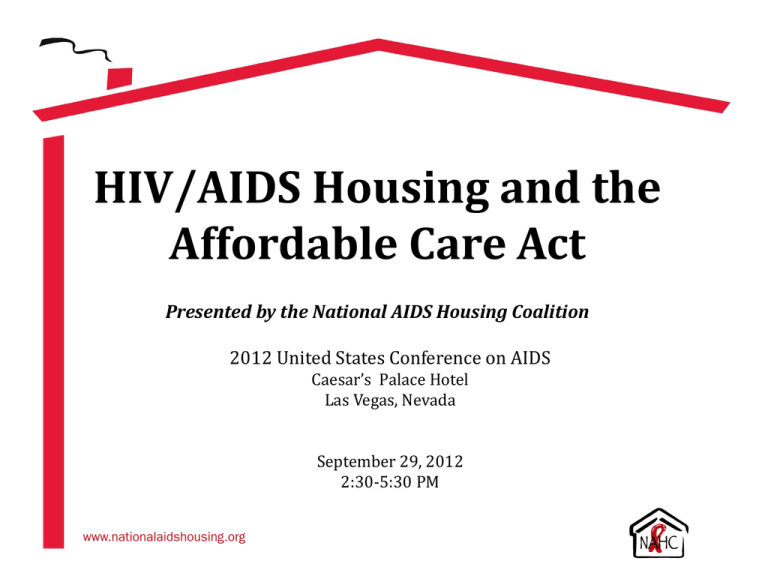
HIV/AIDS Housing and the
Affordable Care Act
Presented by the National AIDS Housing Coalition
2012 United States Conference on AIDS
Caesar’s Palace Hotel
Las Vegas, Nevada
September 29, 2012
2:30-5:30 PM
•
Seminar Faculty Chair
Shawn Lang, CT AIDS Resource Coalition, Hartford, CT
•
Seminar Faculty
Cassandra Ackerman, Columbus, OH
Jeff Allen, Ormond Beach, FL
Art Bendixen, AIDS Foundation Chicago, Chicago, IL
Nancy Bernstine, National AIDS Housing Coalition, Washington, DC
Christine Campbell, Housing Works, Inc., Washington, DC
Michael Kaplan, Cascade AIDS Project, Portland, OR
Kathie Hiers, AIDS Alabama, Birmingham, Alabama
Gina Quattrochi, Bailey House, New York, New York
Ginny Shubert, Shubert Botein Policy Associates, New York, New York
Housing is HIV Prevention
and Health Care: An
Overview
Shawn Lang
Connecticut AIDS Resource Coalition
Homelessness—a major risk factor for HIV infection
• Rates of HIV infection are 3 times to 16 times higher among persons
who are homeless or unstably housed, compared to similar persons
with stable housing.
• 3% to 14% of all homeless persons are HIV positive (10 times the
rate in the general population).
• Over time studies show that among persons at high risk for HIV
infection due to injection drug use or risky sex, those without a
stable home are more likely than others to become infected.
HIV—a major risk factor for homelessness
•
Up to 70% of all PLWHA report a lifetime experience of
homelessness or housing instability.
•
10% to 16% of all PLWHA in some communities are literally
homeless at any time —sleeping in shelters, on the street, in a car or
other place not meant for human habitation.
•
Many more PLWHA are unstably housed, faced with housing
problems or the threat of housing loss.
•
Rates of housing need remain high - as some persons get their
housing needs met others develop housing problems.
Housing instability =
poor health outcomes for PLWHA
•
Homeless/unstably housed PLWHA are less likely to receive
appropriate health care & experience higher rates of opportunistic
infections, HCV and other co-morbidities.
•
The all-cause death rate among homeless PLWHA is five times the
death rate for housed PLWHA.
•
The death rate due to HIV/AIDS is among homeless PLWHA is seven
to nine times the death rate due to HIV/AIDS among the general
population.
•
Poverty is the most significant factor contributing to HIV health
inequities.
Housing status predicts HIV risk behaviors
•
Research shows a direct relationship between housing status and
risk behaviors among extremely low income HIV+ persons with
multiple behavioral issues.
•
Homeless or unstably housed persons were 2 to 6 times more likely
to use hard drugs, share needles or exchange sex than stably housed
persons with the same personal and service use characteristics.
•
Homeless women were 2 to 4 times as likely to have multiple sex
partners as housed indigent women - in part due to the effects of
physical violence.
•
Harm reduction and other behavioral prevention interventions are
much less effective for participants who lack stable housing.
Housing is HIV Medical Care
•
Receipt of housing assistance is among the strongest predictors of accessing
HIV care.
•
Homeless/unstably housed PLWHA whose housing status improves over time are:
– More likely to report HIV primary care visits, continuous care & care that meets clinical
practice standards
– More likely to return to care after drop out
– More likely to be receiving HAART
•
Increased housing stability is positively associated with:
– Effective HAART (viral suppression)
– Better HIV related health status ( as indicated by viral load, CD4 count, lack of coinfection with HCV or TB)
– Significantly decreased mortality (a SF study shows that access to supportive housing
reduced mortality among homeless PLWA 80% over a 5-year period)
Housing is HIV Prevention
• Over time, studies show a strong association between change in
housing status and risk behavior change.
• Over time, persons who improved housing status reduced risk
behaviors by half; while persons whose housing status
worsened over time were 4 times as likely to exchange sex.
• Access to housing also increases access to appropriate care and
antiretroviral medications which lower viral load, reducing the
risk of transmission.
Housing Saves Costs
• People coping with homelessness are frequent users of expensive crisis
services including shelters, jails, and available emergency and hospital
care.
• The CHHP cost analysis documented that improved housing stability
reduces these costs my amounts that more than offset the costs of
housing intervention. Generating an average annual savings of $6,000.
• Each new HIV infection prevented through housing stability saves over
$300,000 in lifetime medical costs.
• An ongoing study of PWHIV enrolled in a SF housing program showed
that median healthcare costs for high users (>$50,000/year) dropped from
$100,000/year prior to housing to $1,819 after placement.
How Supportive Housing
Links with the Affordable
Care Act
Christine Campbell
Housing Works
Overview of the Affordable Care Act
– Signed into law March 2010
• Goal is to decrease the number of uninsured Americans,
improve overall health outcomes and reduce the overall cost
of healthcare
• Despite several state challenges, the Supreme Court upheld
the individual mandate provision and found the Medicaid
Expansion provision coercive thereby allowing states to opt
out without risking federal funding.
Caveats
There is no panacea. Covering the costs of support
services in housing programs continues to be a
challenge.
The Affordable Care Act will be implemented differently
from state to state – what your state implements will be
dependent on strong advocacy and involvement on all
our parts.
Overview of the Affordable Care Act
– Requires insurers to issue policies regardless of medical condition
and the same policies and coverage to people of the same age and
geographical locations regardless of gender or pre-existing
condition
– Health Insurance Exchanges: Individuals and families above 100%
and 400% poverty can purchase insurance with federal subsidies
on a sliding scale
– Medicaid Expansion to all individuals at or below 133% of poverty
Most homeless HIV+ adults will be Medicaid eligible in 2014
Possibilities: Affordable Care Act
and Supportive Housing
Care Management - Health Homes (ACA Section 2703) and
Managed Care Organizations
Home and Community Based Waivers [1915(i) of Social
Security Act – amended by ACA]
– Rehabilitation Option
– Targeted Case Management
Health Home Eligibility
To the extent elected by the State in its approved State
plan, those eligible for Medicaid with:
(1)two or more chronic conditions;
(2)One chronic condition and are at risk for a second; or
(3)a serious and persistent mental health condition.
Chronic conditions identified in statute include mental health, substance
use disorder, asthma, diabetes, heart disease, and being overweight
(as evidenced by a BMI of >25).
States may request that CMS identify other chronic conditions for
purposes of eligibility. States may request to base eligibility on
additional or different chronic conditions in a SPA. While CMS
approval is discretionary, this flexibility provides States the option to
request to expand the chronic conditions list to include more
beneficiaries or use more specific chronic conditions to target the
population.
Health Home Services
•
•
•
•
•
•
Comprehensive care management
Care coordination
Health promotion
Comprehensive transitional care/follow-up
Patient and family support
Referral to community and social support services
Policy and Advocacy Priorities and
Considerations
• States will need to participate in Medicaid Expansion to maximize
funding opportunities
• States and housing providers need to ensure supportive housing is
targeting high need/high cost HIV+ homeless individuals as those
whose health care utilization will be positively impacted through
this approach while achieving future cost savings.
• States will need to determine Medicaid payment option that will
best serve their clients to reimburse supportive housing services
and then advocate for them to be inclusive of the needs of PLWHA’ –
such as getting HIV/AIDS included as a chronic condition.
Policy and Advocacy Priorities and
Considerations
• New organizational configurations with appropriate policies,
regulations and technical assistance, are needed to transition
current supportive housing capacity to Medicaid eligible
environments
• Systems with appropriate funds and training are needed for
tracking and managing costs for HIV+ homeless individuals and
families.
State Health Home Models
New York State’s Health
Home Model
Gina Quattrochi
Bailey House
New York State’s Health Home Model
Health
Information
Technology
Medicaid funded
Targeted
Case Management
transitioned to
Health Home Care Management
Goal
is to provide
comprehensive
medical
management
to
HIT is
strongly
encouraged
in the
SMDcare
letter,
but is not
frequent users of high end Medicaid funded services
required.
If HIT is neither feasible nor appropriate the
State
will need
respond
accordingly
in the
State“locate
Plan
Components
of to
Care
Management
(formerly TCM)
include
and engage” and
shared
medical records
Amendment
(SPA)
submission.
In the absence of HIT,
the
State will need to demonstrate how they achieve the
Reimbursement based on acuity rates – homelessness as “acuity
care
coordination
activities
factor”
being negotiated
in NYS between multiple settings of
a health home through other methods.
New York State’s Health Home Model
Care Management (formerly TCM) is not limited to HIV+
Medicaid users
Not currently designed to fund services in supportive
•TCM is not limited to HIV+ Medicaid users
housing; it’s not a funding stream , it’s a system for medical
case management using Medicaid
•Not designed to fund services in supportive housing
Organizations that become Care Management providers
•Organizations that become TCMs must have or develop
(formerly TCM providers) must have or develop EMR
EMR capacity
(electronic medical record) capacity
Oregon’s Health Home Model
Michael Kaplan
Cascade AIDS Project
Triple Aim:
Vision for Oregon
1.Better health.
2.Better care.
3.Lower costs.
Accountable Care Organizations
• Providers and suppliers work together to
coordinate care for patients under Medicare;
• Goal: Deliver seamless, high quality care;
Improving health outcomes with lower cost.
• Patient-centered organizations with providers,
suppliers and beneficiaries on governing board;
• Must take responsibilities for 5,000 beneficiaries
Difference Between Medicare and
Medicaid
Medicare
Medicaid
• A federal program
attached to social security
• A joint federal and state
program
• Available to all U.S. citizens
65 and older as well as
people with certain
disabilities.
• Helps low-income
individuals and families
• Available regardless of
income
• Often targeted – families,
pregnant women, children
and disable.
• Eligibility rules vary by
state
Coordinated Care Organizations (CCO)
• A local network of all types of health care providers
working together to deliver care for Oregon Health
Plan clients
• Care is coordinated at every point-from where
services are delivered to how the bills are paid
• CCOs shall serve Medicaid population and “dual
eligible (Medicaid and Medicare)” enrollees
Elements of Coordinated Care
Organizations (CCO)
•
Benefits and services are integrated and
coordinated,
•
One global budget that grows at a fixed rate,
•
Local flexibility
•
Local accountability for health and budget
•
Metrics: standards for safe and effective care
Benefits & Services Integrated
• Physical health, behavioral health, dental health
• Focus on chronic disease prevention and
management
• Focus on primary care
• Get better outcomes:
– Health equity
– Prevention
• Community health workers/non-traditional health
workers
• Electronic health records
Oregon’s 1115 Medicaid Waiver
• Allows CCO’s as delivery system for Medicaid
• No reduction in benefits
• Allows use of Medicaid dollars for flexible services
(e.g. - non-traditional health care workers).
• Provides $1.9 Billion over 5 years from feds tied to
state showing reduction in per capita medical trend.
• Quality metrics to ensure savings not through
service reduction, but improved health outcomes
CCO Timeline
• August 1, 2012 – First CCO’s come on line with waves
to follow. Currently – 13 approved as of Sept. 1, 2012
• Not before 2013, but eventually – HIV/AIDS targeted
case management to be included in CCO Global
Budgets
• By 2017 – CCO’s replace Oregon’s Medicaid Managed
Care system
• CCOs include Medicare, State Public Employees &
Private Business Sector – no target date set.
Understanding Oregon’s Epidemic
• 70% of state epidemic in three counties 15%
estimated to be homeless or unstably housed
• 4256 PLWHA in Portland TGA
• In 2007 – ~20% of HIV-positive population in
Oregon enrolled on Medicaid
CAP’s & Housing Program
• CAP – Incorporated in 1985; $5.2 Million budget
• Mission – To prevent HIV infections, support and
empower people affected and infected by HIV/AIDS
and eliminate HIV/AIDS related stigma.
• Housing approx. $2 million of budget – provides
emergency, short-term and long-term housing
support (in 2011 - $871k in direct assistance, 574
individuals supported in housing services)
CAP Housing Clients - Insurers
•
•
•
•
•
OMIP/FMIP – 36%
Medicaid – 31%
Medicare – 16%
Private – 13%
VA – 3%
CCO’s Serving Portland TGA
• Two CCO’s Serving the Tri-County Area (36% of total
Medicaid population – ~ $1.44 Billion)
• Family Care and Oregon Health Share(David & Goliath)
• Oregon Health Share (includes OHSU, 3 counties, 5
Health Systems, one insurer (Care Oregon) and one
Housing/Health Agency (CCC)
• The systems engaged in OHS account for all HIV-positive
patients in care in the tri-county area (Multnomah
County FQHC, Kaiser IDC (50% of all positives)
How to link to Goliath - Challenges
• While CCO’s will include medical, dental and
behavioral health, no discussion or plan of how
housing funds link
• Housing funds have greatest opportunity to impact
frequent fliers
• HOPWA at CAP comes through city & state, while
Ryan White & most of prevention through counties
and CCO includes counties, but not city or state
Current Effort / Strategies
• Be at the table, inclusion in discussions as CCOs form.
• Linking our work to CCO’s
– Every Housing Case Manager linked to a Medical Case
Manager
– HRSA/SPNS – allow staff to input into EPIQ
– Starting to look at ability to bill under sub-contract to
Medicaid
– Create/expand our own non-traditional health care
workers (mental health peer specialists)
The Marriage (or engagement or
hook-up) of AIDS Housing with the
ACA’s Health Homes, ACOs, or
Other Health Plans
“A Chicago Model”
Arturo V. Bendixen
AIDS Foundation of Chicago
HHS Mantra for the ACA
• Increase access to care
• Increase quality / outcomes
• Decrease costs
32,000,000 uninsured
will become insured….
Up to 16,000,000 of
them through Medicaid
Changed Landscape - $$$
• No more “fee for service”
• Required coordinated care – NO
MORE SILOS
• Increase health outcome
• DECREASE COSTS
Hospital Days
Intervention
Group: 2.7
fewer days
than the Usual
Care Group
Emergency Room Visits
Intervention
Group: 1.2
fewer visits
than the Usual
Care Group
Nursing Home Days
Intervention
Group: 37%
Usual Care
Group: 63%
Survival with Intact Immunity
60%
55%
P = 0.04
50%
40%
34%
30%
Intervention
Usual Care
20%
10%
0%
Survival with CD4>200 and
VL<100K
For every 100 chronically
homeless HIV positive
individuals housed, there
is a savings of a $1 million
in public funds
The new world
of USA health care NEEDS
AIDS Housing to save
$$$$$$$$$$$$$$$
FOCUS ON HIGH USERS OF
MEDICAID
Ways to Reduce Costs
• AIDS Housing
• Shared electronic
medical records
• Coordinated care for those with at least
two chronic illnesses
• Outcome based treatment
IL Medicaid Health Homes
Care Coordination Entities (CCE)
• Will include FQHCs,
hospitals, behavioral
health centers, pharmacies...
• MOUs with permanent
supportive housing organizations
• Will receive care coordination payments
Cost Breakdown – First 10 HIV positive
Hospitalizations 45%
Medications 36%
Clinic Visits 10%
Other 4%
Long Term Care 1%
Outpatient Hospital 4%
AIDS Housing: Reduces Costs
• 1/2 (50%) of spending on:
– Hospitalizations,
– Emergency room visits
– Nursing home stays
• CHHP Study: Significant $$$ Reduction and
Suppressed Vital Loads
Care Coordination
• Role of Case Managers on Team
• Low Barrier Appointment Access
– Monitoring Appointments
• Integration of Physical and Behavioral
Health
• Electronic Health Records
• Monitoring Medication Compliance
Ways to Reduce Costs
• Coordinated care for those with living
with chronic illnesses
• Shared electronic medical records
• Outcome based treatment
• Braided funding / AIDS Housing
Braided Funding
PSH Project with 48 units / health homes:
• HUD pays rental subsidy
• Medicaid pays for some of case
management / care coordination
• Other sources: SAMHSA, Ryan
White,……..
• Private dollars……
The marriage or engagement or hook-up of
AIDS Housing with the ACA’s Health
Homes, ACOs, or Other Health Plans
WE HAVE MUCH ON OUR SIDE
Advocacy Needs in States
Moving Forward with ACA
Implementation and in States
Refusing Medicaid Expansion
What’s Happening in Your
State?
Cost Savings from ACA
Implementation
Christine Campbell
Housing Works
Housing Advocacy in NYS ACA Implementation:
Engaging with the NYS Medicaid Redesign Process
• Context: NYS process for major delivery system reform through
the ACA health home option for chronically ill Medicaid recipients
• Goal: Housing as health care for persons living with HIV
– Funding for housing as a core component of the health home model
– Gain the support of Medicaid and Public Health agencies for housing advocacy
• Strategy: Cost analyses to demonstrate potential Medicaid saving
from increased HIV housing resources
Overall Strategy: Support for ongoing
housing campaigns
Compare housing costs and potential Medicaid savings
to build support ongoing HIV housing advocacy
campaigns:
– For a 30% rent cap affordability protection for disabled PLHWA
receiving state/city rental assistance (to prevent housing loss in
independent living)
– For expanded eligibility for existing HIV housing resources to all
homeless HIV-positive persons, not just those with an AIDS diagnosis
– For state-wide access to proven HIV housing rental assistance
program that is currently available only in New York City
– For housing as HIV prevention for homeless at risk LGBTQ youth
We Have the Facts: Projecting
Savings from HIV Housing
•
Formula: annual housing costs compared to annual Medicaid savings
–
–
•
Medicaid savings – published research on housing & HIV outcomes:
–
–
–
•
Housing costs = per unit costs times unmet need
Medicaid savings = better HIV health care utilization + savings from averted infections
SF Department of Public Health data show a mean decrease of $15,000 per year in health
care costs for each homeless PLWHA placed in housing (appropriate care increases while
expensive crisis care & hospitalizations go down)
Conservative estimate of 5% reduction in annual HIV transmissions for homeless PLWHA
who get housed (rates range from 2.4 and 10.79, with unstably housed at the higher end)
Lifetime healthcare costs of at least $370,000 for each new HIV infection
Housing costs – local data on unmet need and per person costs:
–
–
For rent cap, calculated the incremental cost as $175/month/person
For other initiatives to expand HIV housing, estimated annual per unit cost at $14,400
(which includes a mix of rental subsidies and supportive housing units)
NY Housing Proposals –
Annual Costs vs. Savings
Activities & Outcomes to Date
(Some progress but much more to be done)
• Establishment of a Housing Workgroup as part of the State’s ongoing
Medicaid Redesign process
• Active and ongoing involvement of HIV providers and advocates in
the Redesign process, including the Housing & Medical Disparities
Workgroups
• Circulation of an HIV housing briefing paper with research findings
on housing & HIV health and the HIV housing cost analyses
presented here
• A requirement that NYS networks of health home providers include
partnerships with housing agencies
• Specific plans to invest Medicaid savings in housing are included in a
NYS request to reinvest up to $10 billion of the anticipated federal
savings from the State’s health home initiative
Ryan White and HOPWA
The Perfect Marriage?
Kathie Hiers
CEO, AIDS Alabama
Ryan White Reauthorization:
September 30, 2013
• Ryan White doesn’t
“sunset” or end, but
appropriations must be
approved by Congress
• The Administration has
already indicated that the
Ryan White money for
ADAP will be needed to
offset costs of Affordable
Care Act (ACA)
• In best-case scenario, many
will be left out of ACA
coverage
States Positions on the
ACA Supreme Court Case
ACA Implementation Looks
Different In Every State
ACA Statute
Federal
Regulations or
Guidance
State
Flexibility
So Who Will Not Benefit from ACA?
• Undocumented
• Legal immigrants in U.S. less than five
years
• Those eligible for Medicaid who were
not enrolled
• People in states that do not expand
Medicaid
• People who fall victim to co-pays that
are out of reach
• People who need dental services
• People who fall through the cracks!
Medicaid Expansion: State Planning in the
Midst of Uncertainty
What happens in a state that does not expand?
Greater role for Ryan White Program/ADAP
Essential Health Benefits (EHB):
What We Know
• States selecting from ten benchmark options to
set the standard for their EHB
• State benchmark selection due Sept 30th
• Largest small group plan in the state is the
default
– Generally lowest cost option, more service limits,
etc.
• Regulations delayed…until after elections?
Essential Health Benefits: Will Private Insurance
Benchmark Plan Cover Necessary Care and Treatment?
Essential Health Benefits: Will Medicaid Benchmark
Plan Cover Necessary Care and Treatment?
• Medicaid benchmark plans have been used
by states to offer slimmer benefits packages:
– Wisconsin BadgerCare Core Plan:
• Restricted formulary
– No branded ARVs
• Co-payments
• Service limits
Exchange Activity: Where the States Are
Ryan White Continues to be Critical
• Most Ryan White recipients are low
income
• Wraparound services allow people to
remain in care
• Without stable housing, transportation,
non-medical case management, and
other services, stable medical care is
impossible
• Ryan White could become the safety net
that the legislation was meant to be
• Will the 75% core medical/25% support
services still be appropriate?
HIV Community Must Unite to Keep
Ryan White Funded
How Much Pressure Can Ryan White Take?
How Much Will Be Left for Housing?
HOPWA Formula: The Glue That Holds It
All Together
HOPWA funds may be used for….
• A wide range of housing, social services, program
planning, and development costs, including
acquisition, rehabilitation, or new construction of
housing units; costs for facility operations; rental
assistance; and short-term payments to prevent
homelessness.
•Also mental health services, chemical
dependency treatment, nutritional services, case
management, assistance with daily living, and
other supportive services.
HUD’s Housing Opportunities for
Persons With AIDS (HOPWA)
HOPWA Formula Program uses a
statutory method to allocate HOPWA
funds to eligible states and cities on
behalf of their metropolitan areas (90%
of funding).
HOPWA Competitive Program is a
national competition to select model
projects or programs (10% of funding).
HOPWA Technical Assistance is now
provided along with other more
mainstream HUD housing programs.
HOPWA Formula: Rental Assistance
• Low income and HIV/AIDS
• Tenant- or project-based assistance
• Based on action plans approved in City and State
Consolidated Plans
• Funding based on annual allocation from HUD (threeyear use period)
• HOPWA may provide short term (STRMU) assistance (up
to 21 weeks) to prevent homelessness
• HOPWA may provide long-term, tenant-based rental
assistance (TBRA) for eligible tenants with constant need
Every State Is Different!
• AIDS Alabama
provides assistance to
all 67 counties through
a partnership with the
AIDS Service
Organizations.
• Some states don’t help
in rural areas.
• Some states offer longterm help; some don’t.
Who runs your HOPWA program?
HOPWA Formula: Modernize to HIV
National HIV/AIDS Strategy action during 2011:
HUD will work with Congress to develop a plan (including seeking
statutory changes if necessary) to shift to HIV/AIDS case reporting as a
basis for formula grants for HOPWA funding.
1. Action needed to shift HOPWA data source to HIV case reports
• # of persons living with HIV seen as the best measure of the epidemic’s burden by area (852,982
persons, year end 2008), expectation of more mature HIV reporting nationally by 2013.
• Data on HIV now available from the Centers for Disease Control and Prevention, CDC.
Current HOPWA formula uses cumulative AIDS cases (e.g.
cases since 1981) – weighted for 75% of funds.
•FY 2011 was based on 1,107,329 cumulative AIDS cases as of 3-31-10, statutory date.
•The cumulative data includes case reporting on 608,288 deaths.
•Amounts (75% of formula amounts, $223.416 million) shared in direct
proportion for all 134 eligible areas based on CDC data
HOPWA Formula: Modernize to HIV
2. Current formula also uses AIDS incidence (e.g. new cases
and population reported in last three years) – weighted at
25% of funds
•FY 2011 was based on 90,737 cases of AIDS reported (3-31-10) as included in cumulative data.
•Used to determine area incidence per updated population to identify metropolitan areas with
higher than average incidence of AIDS.
•At 25% of funding ($74.472 million), this factor is shared by 31 of 84 MSAs with the 41
states/PR also not eligible; Initial year 1992 involved $11 million and 14 cities.
•Distributed based on number of cases in “excess” above average, with 7,425 cases used in
this factor’s distribution (i.e. 8.2% of this recent AIDS case subset, only 0.6% of overall
AIDS data).
•Super-targeted as largest 7 of 31 MSA receive 72% of this factor (top 3 with
48.6%) with per case impact at $10,030 compared to cumulative case impact at
$202 per grantee.
HOPWA ideas for targeting
3. Targeting to needs along with greater equity for households by addressing
housing costs & community resources – consider how to target, such as:
Fair Market Rents (FMR)
•
Recognize differences in housing costs in area rents, as
reflected in HUD FMR standards, annual updates (e.g. range
of $1,833 in SF to $574 in AR; $468 in PR)
Poverty
•
Recognize difficulties in service delivery in areas of
concentrated poverty (e.g. range of 5.08 % in Islip to
26.6% in El Paso; 52.6% in PR)
Consider if incidence or prevalence is useful in targeting, or that the number of persons
living with HIV is more relevant to reflect the national impact of HIV along with associated
housing service delivery costs & burdens
Will Housing Opportunities for Persons with AIDS
(HOPWA) Distribution Methodology Ever Be Updated?
• Appropriates 25% of formula dollars as
bonus to limited number of large urban
areas with highest AIDS incidence
• Distributes balance of formula dollars to
all jurisdictions, including bonus
recipients, based only on cumulative AIDS
cases, including 610,000 deceased persons
• Does not utilize HIV cases, which punishes
the South and other areas of the country
with a newer epidemic and a higher HIV to
AIDS ratio
• Must be changed by Congress
• NHAS Implementation Plan tells HUD to
get it done by end of 2011!
Advocate!
Never underestimate
the power of a small
group of committed
people to change the
world. In fact, it is the
only thing that ever
has.
- Margaret Mead
The Squeaky Wheel Gets the Oil
• Become that squeaky
wheel!
• Be respectful, but never go
away.
• Develop grassroots
networks locally,
statewide, regionally, and
federally.
• Your voice and your story
are just as important as
anyone else’s.
Affordable Care Act
Implementation
Nancy Bernstine
National AIDS Housing Coalition
Health Care Reform Implementation
2013
2014
Closing the Medicare Drug
Coverage Gap
Medicaid Coverage of
Preventive Services
Medicaid Payments for
Primary Care
Expanded Medicaid Coverage
Individual Requirement to Have
Insurance
Health Insurance Exchanges
Health Insurance Premiums and
Cost Sharing Subsidies
Guaranteed Availability of
Insurance
No Annual Limits on Coverage
Essential Health Benefits
Basic Health Plan
Essential Advocacy to Ensure
Housing is Part of the Future
Christine Campbell
Housing Works
Thank You for Joining Us!
Questions?


